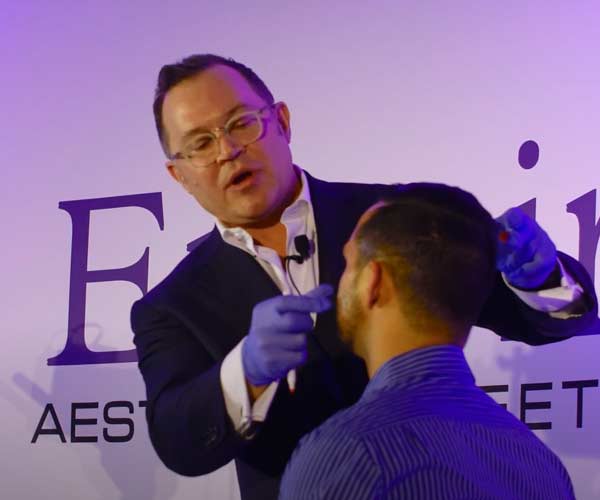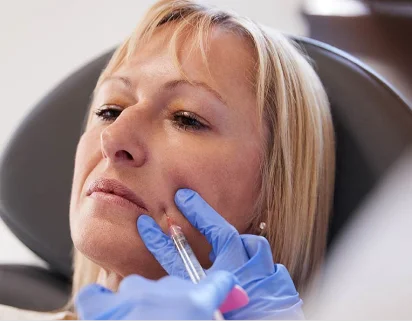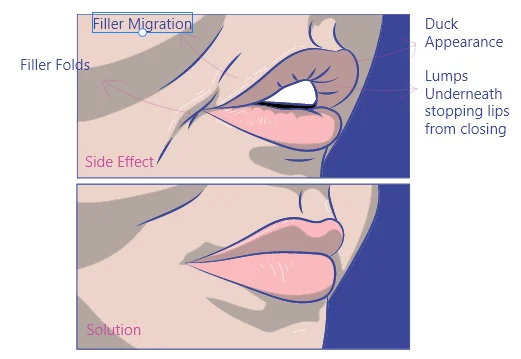Face Fillers Side Effects
By Dr. Stephen Cosentino
PRESIDENT OF EMPIRE MEDICAL TRAINING
DERMAL FILLER | MAY 24, 2021

Face Fillers
Side Effects
Entry made by
Empire Medical Training
Injectable dermal fillers are among the most popular minimally invasive alternatives to plastic surgery, second only to botulinum
toxin type A (Botox®) procedures, according to data from the American Society of Plastic Surgeons.
Face fillers, as they’re also known, are used to achieve temporary or permanent results that address a variety of cosmetic
issues, including volume loss in the cheeks and lips, lines and wrinkles around the face and neck area, and other superficial signs of aging.
Face fillers are FDA approved to treat many cosmetic conditions of the face
and are generally regarded as safe in comparison to more invasive surgical procedures, including grafting. But no medical procedure is entirely without possible side effects and complications. Patients considering this type
of treatment should carefully weigh known face fillers side effects in consultation with a trained, board-certified medical provider before moving forward.
Patients can also use this guide to reach an informed decision.
It covers:
- Known face fillers side effects patients should watch for
- Risk factors for side effects from dermal fillers
- How to choose a trained treatment provider and further reduce risk
- How to weigh the risks and benefits of face filler treatments
Face Fillers Side Effects to Watch For
Most face fillers side effects are mild and temporary, resolving on their own over a period of days to weeks without lasting health or cosmetic consequences. In rare cases, more concerning side effects or complications can develop
and cause more serious or longer-lasting issues.
The likelihood of specific post-treatment side effects varies by filler type, injection site, injection technique, and patient-specific factors (both preexisting contraindications
and post-treatment behaviors). However, the four main types of synthetic and non-synthetic non-autologous dermal fillers do share many side effects in common:
- Poly L lactic acid (Sculptra®)
- Calcium hydroxylapatite (Radiesse®)
- Hyaluronic acid (Juvederm®, Restylane®)
- Polymethylmethacrylate (Bellafil®l, a permanent type of lip fillers)
Common Side Effects That Tend to Be Mild
These dermal filler side effects tend to be mild, temporary, and self-limiting:
-
Swelling or redness at the injection site. Some degree of swelling is common after injection and usually resolves within a few days.
-
Redness or rash-like presentations may also occur shortly after treatment.
-
Pain and bruising at the injection site. Pain or discomfort and mild to moderate bruising are to be expected following dermal filler injection. Most dermal filler injections contain lidocaine, a local numbing agent.
- Itchiness around the injection site. Mild itchiness should resolve within a few days of treatment. Patients should report persistent itchiness, as it may be a sign of an allergic reaction or skin infection.
Rarer Side Effects of Concern
While rare and not necessarily of urgent medical concern, certain dermal filler side effects warrant closer monitoring than those above and may require medical intervention if they do not resolve on their own:
-
Skin bumps or nodules at the injection site. These are usually painless but can be unsightly and often necessitate surgical removal.
-
Granulomas (inflammatory reaction). Granuloma is another type of bumpy post-injection skin reaction caused by the body’s immune response to the filler.
-
Skin infection. Post-injection skin reaction generally requires treatment with antibiotics and must be monitored closely to spot signs of necrosis (skin cell death) or spread.
-
Filler leakage. In rare cases attributable to improper injection technique, filler may leak through the injection site and require follow-up corrective treatments.
- Tyndall effect. The Tyndall effect is a bluing of the skin around the injection site. Though usually temporary, the effect can persist for weeks and is unsightly. If noticed promptly, the Tyndall effect is treatable with massage. Otherwise, follow-up treatment may be required to neutralize the filler.
More Serious Side Effects
This last class of side effects is rare but can result in serious health consequences, including disability:
-
Severe allergic reaction. Known as anaphylaxis, this type of reaction is marked by shortness of breath and severe swelling of the skin. It requires immediate medical intervention.
-
Filler migration. In rarer cases, filler can migrate from the treatment area to more distant parts of the body. This can have unpredictable and potentially serious health consequences and may require internal surgery to correct.
-
Blood clots. When injected into larger blood vessels, dermal fillers can induce the formation of blood clots. Complications arising from these clots can include stroke, blurred vision or temporary or permanent blindness (due blockage of blood flow to
the eye), and skin necrosis (death of skin cells due to lack of blood flow).
-
Scarring at the injection site. Improper filler administration is associated with scarring around the injection site. This effect can bepermanent.

Are Some People at Higher Risk of Face Filler Side Effects?
Certain preexisting conditions may put candidates at higher risk of face filler side effects. Some such conditions are considered contraindications, meaning they render the patient unsuitable to proceed with treatment. The most common contraindications include:
- Current skin infection in or near the proposed treatment area
- Current facial or oral herpes infection
- Allergy to any filler component, including lidocaine
- Current pregnancy or breastfeeding
- Known blood-clotting issues or a history of blood clots
- Uncontrolled diabetes
- Current immunosuppressed condition due to a medical condition or treatment, including immunosuppressive medications
Are Face Fillers Worth It?
In light of the possible risks, it’s reasonable for treatment candidates to ask whether face fillers are worth it at all.
The answer depends on a variety of factors, including:
-
The type of filler being considered. Face filler risks vary by type and formulation, and it’s important for patients to consult with their treatment provider before assuming that the risks of any particular filler match those of any other.
-
Whether the filler is part of a broader cosmetic treatment plan. Patients who undergo filler treatment in conjunction with other types of cosmetic augmentation or surgery, such as lip implants, Botox, or autologous fat grafts, may face greater levels
of risk than patients who only receive a particular type of face filler.
-
The patient’s baseline risk of side effects or complications from injectable treatment of face fillers. The risk factors enumerated above can affect a patient’s baseline risk and influence their decision to proceed with treatment. While trained providers
should exclude patients with known contraindications from treatment, not all contraindications or risk factors may be known to the patient or provider or become apparent during pre-treatment consultation and screening.
-
The desired duration of results. Certain dermal fillers’ results are temporary. For example, hyaluronic acid filler results generally last 6 to 18 months, while calcium hydroxylapatite results last about two years. Others, such as PMMA, are functionally
permanent. In consultation with their treatment providers, patients should weigh how long they desire results with the potential for longer-term side effects.


